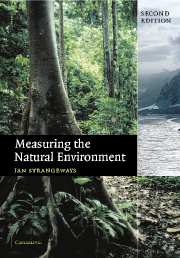Book contents
- Frontmatter
- Contents
- Acknowledgements
- 1 Basics
- 2 Radiation
- 3 Temperature
- 4 Humidity
- 5 Wind
- 6 Barometric pressure
- 7 Evaporation
- 8 Precipitation
- 9 Soil moisture and groundwater
- 10 Rivers and lakes
- 11 Data logging
- 12 Telemetry
- 13 Visibility
- 14 Clouds
- 15 Lightning
- 16 The upper atmosphere
- 17 The oceans
- 18 Cold regions
- 19 Remote sensing
- 20 Atmospheric composition
- 21 Forward look
- Appendix: abbreviations and acronyms
- Index
- References
6 - Barometric pressure
Published online by Cambridge University Press: 05 July 2014
- Frontmatter
- Contents
- Acknowledgements
- 1 Basics
- 2 Radiation
- 3 Temperature
- 4 Humidity
- 5 Wind
- 6 Barometric pressure
- 7 Evaporation
- 8 Precipitation
- 9 Soil moisture and groundwater
- 10 Rivers and lakes
- 11 Data logging
- 12 Telemetry
- 13 Visibility
- 14 Clouds
- 15 Lightning
- 16 The upper atmosphere
- 17 The oceans
- 18 Cold regions
- 19 Remote sensing
- 20 Atmospheric composition
- 21 Forward look
- Appendix: abbreviations and acronyms
- Index
- References
Summary
It stood very low — incredibly low, so low that Captain MacWhirr grunted. The match went out, and hurriedly he extracted another, with thick, stiff fingers. There was no mistake. It was the lowest reading he had ever seen in his life. Perhaps something had gone wrong with the thing! There was an aneroid glass screwed above the couch. He turned that way, struck another match and discovered the white face of the other instrument looking at him from the bulkhead, meaningly, not to be gainsaid, as though the wisdom of men were made unerring by the indifference of matter. There was no room for doubt now. The worst was to come, then — and if the books were right this worst would be very bad.
Joseph Conrad Typhoon.The variable and its history
The Torricelli experiment did not come about by accident, but had its origins early in seventeenth century Italy in a question first asked 2300 years earlier by Aristotle as to whether a vacuum could be made or could exist naturally. Aristotle's view was that it could not, because he believed that there would be no dimensions in a vacuum – no up, down, north, south, east or west, and that light could not pass through it. This was still a common view even in the seventeenth century. There was also uncertainty over whether air had weight or exerted pressure on objects submerged in it. The same doubts existed concerning water.
- Type
- Chapter
- Information
- Measuring the Natural Environment , pp. 91 - 112Publisher: Cambridge University PressPrint publication year: 2003



